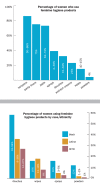A question for women's health: chemicals in feminine hygiene products and personal lubricants
- PMID: 24583634
- PMCID: PMC3948026
- DOI: 10.1289/ehp.122-A70
A question for women's health: chemicals in feminine hygiene products and personal lubricants
Figures



Comment in
-
Changing trends in phthalate exposures.Environ Health Perspect. 2014 Oct;122(10):A264. doi: 10.1289/ehp.1408629. Environ Health Perspect. 2014. PMID: 25272327 Free PMC article. No abstract available.
References
-
- Euromonitor International. Country Report: Sanitary Protection in the US. London, UK:Euromonitor International (June 2013). Available: http://www.euromonitor.com/sanitary-protection-in-the-us/report [accessed 24 January 2104].
-
- Scranton A. Chem Fatale: Potential Health Effects of Toxic Chemicals in Feminine Care Products. Missoula, MT:Women’s Voices for the Earth (November 2013). Available: http://goo.gl/BgIwdu [accessed 24 January 2014].
-
- H.R. 2332 (112th Congress): Robin Danielson Act. Available: http://thomas.loc.gov/cgi-bin/query/z?c112:H.R.2332: [accessed 24 January 2014].
Publication types
MeSH terms
Substances
LinkOut - more resources
Full Text Sources
Other Literature Sources
Medical

